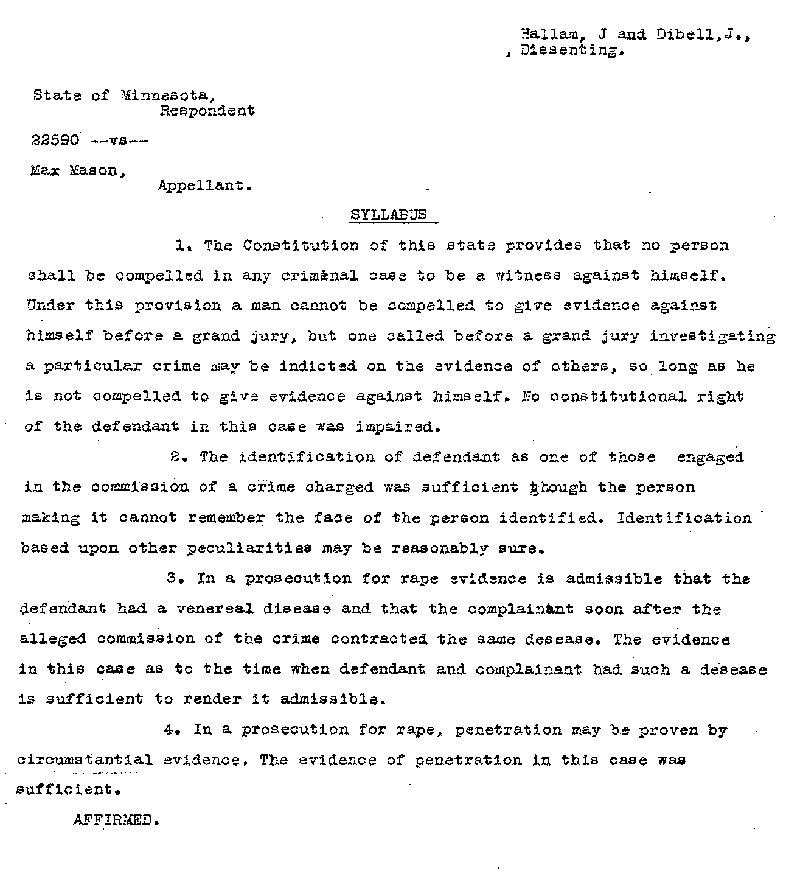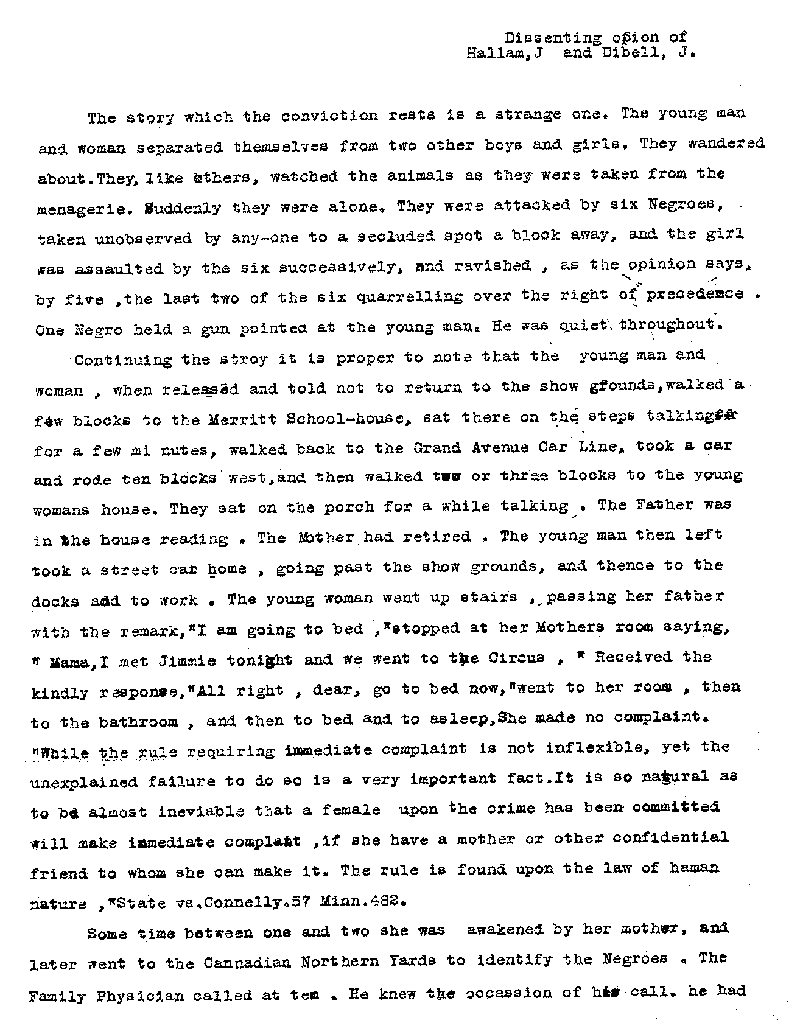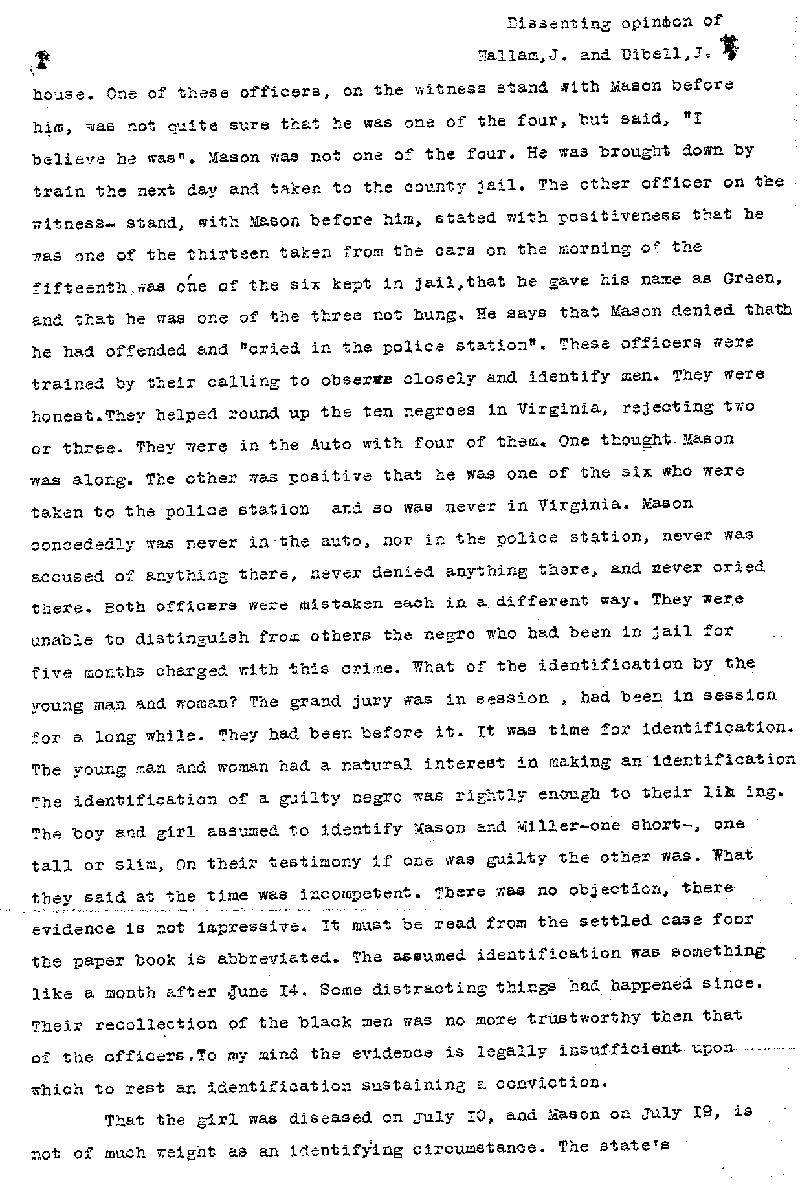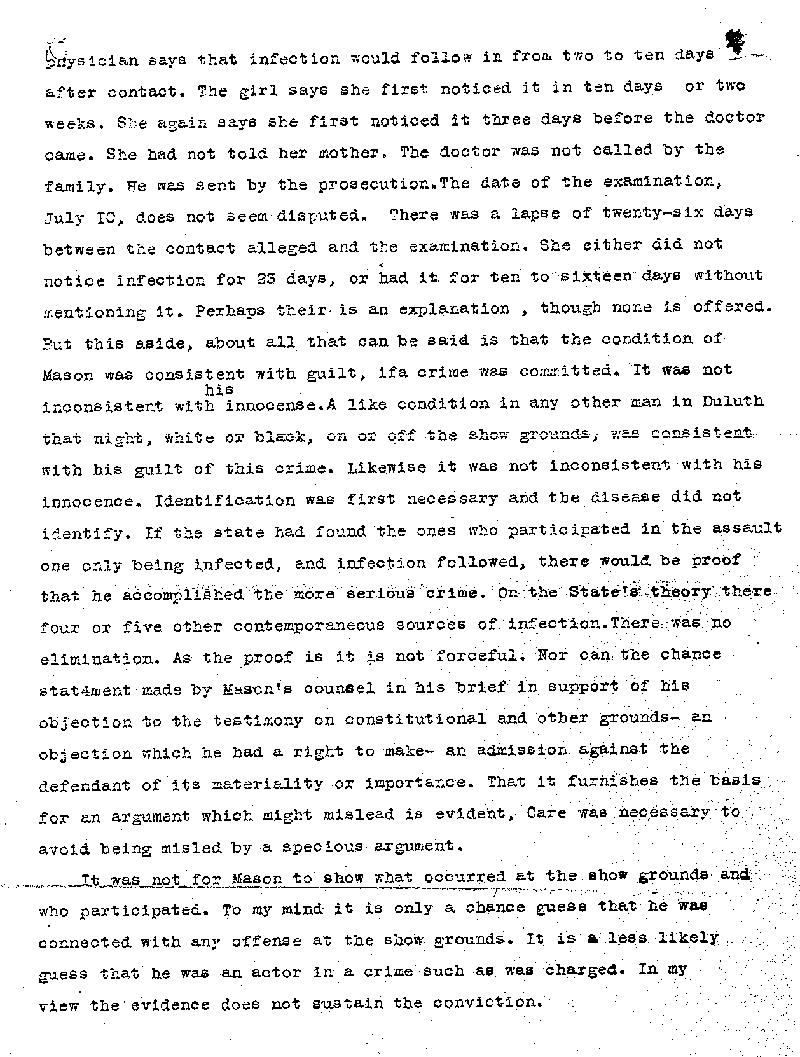Max Mason. Case No. 6785. Supreme Court Syllabus and Dissent.
Type of event: Incarcerations
Location: Stillwater; Washington County; Minnesota; United States
Document date:
Document type: Gov't Record(s)
Document subtype: Supreme Court Syllabus and Dissent
Documents: Max Mason. Case No. 6785. Supreme Court Syllabus and Dissent.
Citation:
Minnesota State Prison (Stillwater, Minn.) [Stillwater State Prison].
Max Mason: Case No. 6785.
Case Files.
Supreme Court Syllabus and Dissent.
Image text
Hallam, J. and Dibell, J.,
Dissenting.
State of Minnesota,
Respondent
22590 –-vs—
Max Mason,
Appellant.
SYLLABUS
1. The constitution of this state provides that no person shall be compelled
in any criminal case to be a witness against himself. Under this provision a man
cannot be compelled to give evidence against himself before a grand jury, but
one called before a grand jury investigating a particular crime may be indicted
on the evidence of others, so long as he is not compelled to give evidence
against himself. No constitutional right of the defendant in this case was
impaired.
2. The identification of defendant as one of those engaged in the
commission of a crime charged was sufficient. Identification may be sufficient
though the person making it cannot remember the face of the person identified.
Identification based upon other peculiarities may be reasonably sure.
3. In
a prosecution for rape evidence is admissible that the defendant had a venereal
disease and that the complainant soon after the alleged commission of the crime
contracted the same disease. The evidence in this case as to the time when
defendant and complainant had such a disease is sufficient to render it
admissible.
4. In a prosecution for rape, penetration may be proven by
circumstantial evidence. The evidence of penetration in this case was
sufficient.
Affirmed.
Dissenting opinion of
Hallam, J and Dibell, J.
The story upon which the conviction rests is a strange one. The young man and
woman separated themselves from two other boys and girls. They wandered about.
They, like others, watched the animals as they were taken from the menagerie.
Suddenly they were alone. They were attacked by six negroes, taken unobserved by
anyone to a secluded spot a block away, and this girl was assaulted by the six
successively, and ravished, as the opinion says, by five, the last two of the
six quarreling over the right of precedence. One Negro held a gun pointed at the
young man. He was quiet throughout.
Continuing the story it is proper to
note that the young man and woman, when released and told not to return to the
show grounds, walked a few blocks to the Merritt school-house, sat there on the
steps talking for a few minutes, walked beck to the Grand avenue car line, took
a car and rode west ten blocks, and then walked two or three blocks to the young
woman’s home. They sat on the porch for a while talking. The father was in
the house reading. The mother had retired. The young man then left, took the
street car home, going past the show grounds, and thence to the docks and to
work. The young woman went upstairs, passing her father with the remark,
“I am going to bed,” stopped at her mother’s room, saying,
“Mama, I met Jimmie tonight and we went to the circus,” received the
kindly response, “All right, dear, go to bed now,” went to her room,
then to the bathroom, and then to bed an to sleep. She made no complaint.
“While the rule requiring immediate complaint is not inflexible, yet the
unexplained failure to do so is a very important fact. It is so natural as to be
almost inevitable that a female upon whom the crime had been committed will make
immediate complaint, if she have a mother or other confidential friend to whom
she can make it. The rule is founded upon the laws of human nature.” State
v. Connelly, 57 Minn. 452.
Some time between one and two she was awakened by
her mother, and later went to the Canadian Northern yards to identify the
negroes. The family physician called at ten. He knew the occasion of his call.
He had
Dissenting opinion of
Hallam, J and Dibell, J.
He had (sic) the sympathy attendant upon the relation of family physician
and patient. He “found a normal condition,” though “she seemed
slightly nervous; the physical condition was good.” His examination was
through. There were no abrasions nor bruises nor inflammation nor evidence of
soreness or tenderness. He did not call again. Some of the best evidence of a
crime, if there was one of this kind, was not preserved. State v. Cowing, 99
Minn. 123, 134. There is other testimony that the girl was “very
hysterical and nervous” for several days. So were other Duluth people in
the days following June 14. Mason denied that he was guilty, claimed that her
was at work, and was corroborated by some of his Negro fellow workers. There is
perhaps a possibility that six negroes committed the crime just as charged.
Convictions are not rested on possibilities. This story in its entirety is
unusual and strikingly improbable.
Now pass to the identification. Mason was
brought before the young man and woman at the yards about 5 in the morning of
June 15. They did not identify him. There is testimony that the girl shook her
head when Mason was presented. He was discharged and went to Virginia with the
show. The boy and girl assumed to identify some, partially at least, and they
and the officers selected from the 100 or 120 negroes following the show
thirteen as likely suspects. They were taken to the city jail. Seven were
released before noon. That left six. Three were hung that night. That left
three. The three who escaped hanging were spirited to Superior and brought to
the county jail the next day. Ten were brought down from Virginia later, Max
Mason among them, and taken to the county jail, so there were thirteen in the
jail for the grand jury.
It is common knowledge that colored men are not
easily distinguished in daytime and less readily in the dark or in the twilight.
Young southern negroes, such as these, look much alike to the northerner. The
proof is in the case. Mason and nine others were arrested at Virginia on the
15th. Two officers who were active in the work of identification at the yards in
the morning went there and apprehended them. They started to Duluth by auto with
four of them. They were stopped a few miles back of Duluth because of the
lynching in progress, and the negroes were kept overnight in a nearby
Dissenting opinion of
Hallam, J and Dibell, J.
house. One of these officers, on the witness stand with Mason before
him, was not quite sure that he was one of the four, but said, “I believe
he was.” Mason was not one of the four. He was brought down by train the
next day and taken to the county jail. The other officer, on the witness stand,
with Mason before him, stated with positiveness that he was one of the thirteen
taken from the cars on the morning of the fifteenth, was one of the six kept in
jail, that he gave his name as Green, and that he was of the three not hung. He
says that Mason denied that he had offended and “cried in the police
station.” These officers were trained by their calling to observe closely
and identify men. They were honest. They helped round up the ten negroes at
Virginia, rejecting two or three. They were in the auto with four of them. One
thought Mason was along. The other was positive that he was one of the six who
were taken to the police station, and so was never in Virginia. Mason concededly
was never in the auto, nor in the police station, never was accused of anything
there, never denied anything there, and never cried there. Both officers were
mistaken, each in a different way. They were unable to distinguish from others
the Negro who had been in jail for five months charged with this crime, what of
the identification by the young man and woman? The grand jury was in
session—had been in session for a long while. They had been before it. It
was time for an identification. The young man and woman and the officers had
some natural interest in making an identification. The identification of a
guilty Negro was rightly enough to their liking. The boy and girl assumed to
identify Mason and Miller—one short, one tall or slim. On their testimony
if one was guilty the other was. What they said at the time was incompetent.
There was no objection. Their evidence is not impressive. It must be read from
the settled case for the paper book is abbreviated. The assumed identification
was something like a month after June 14. Some distracting things had happened
since. Their recollection of the black men was no more trustworthy then that of
the officers. To my mind the evidence is legally insufficient upon which to rest
an identification sustaining a conviction.
That the girl was diseased on
July 10, and Mason on July 19, is not of much weight as an identifying
circumstance. The state’s
Dissenting opinion of
Hallam, J and Dibell, J.
physician says that infection would follow in from two to ten days after
contact. The girl says she first noticed it in ten days or two weeks. She again
says that she first noticed it three days before the doctor came. She had not
told her mother. The doctor was not called by the family. He was sent by the
prosecution. The date of the examination, July 10, does not seem disputed. There
was a lapse of twenty-six days between the contact alleged and the examination.
She either did not notice infection for 23 days, or had it for 10 to 16 days
without mentioning it. Perhaps there is an explanation, though none is offered.
But this aside, about all that can be said is that the condition of Mason was
consistent with guilt, if a crime was committed. It was not inconsistent with
his innocence. A like condition in any other man in Duluth that night, white or
black, on or off the show grounds, was consistent with his guilt of this crime.
Likewise it was not inconsistent with his innocence. Identification was first
necessary and the disease did not identify. If the state had found the ones who
participated in the assault, one only being infected, and infection followed,
there would be proof that he accomplished the more serious crime. On the
state’s theory there were for or five other contemporaneous sources of
infection. There was no elimination. As the proof is it is not forceful. Nor is
the chance statement made by Mason’s counsel in his brief in support of
his objection to the testimony on constitutional and other grounds—an
objection which he had a right to make—an admission against the defendant
of its materiality or importance. That it furnishes the basis for an argument
which might mislead is evident. Care was necessary to avoid being misled by a
specious argument.
It was not for Mason to show what occurred at the show
grounds and who participated. To my mind it is only a chance guess that he was
connected with any offense at the show grounds. It is a less likely guess that
he was an actor in a crime such as is charged. In my view the evidence does not
sustain the conviction.





